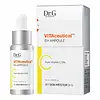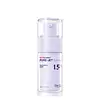What's inside
What's inside
 Key Ingredients
Key Ingredients

 Benefits
Benefits

 Concerns
Concerns

 Ingredients Side-by-side
Ingredients Side-by-side

Water
Skin ConditioningTerminalia Ferdinandiana Fruit Extract
AntioxidantAscorbic Acid 15%
AntioxidantEthoxydiglycol
HumectantGlycerin
HumectantMethyl Gluceth-20
Humectant1,2-Hexanediol
Skin ConditioningC12-13 Pareth-9
EmulsifyingTromethamine
BufferingAcetyl Glucosamine
Skin ConditioningTocopherol 1%
AntioxidantPanthenol 1%
Skin ConditioningBisabolol
MaskingPinus Pinaster Bark Extract
AntioxidantFerulic Acid
AntimicrobialButylene Glycol
HumectantPentylene Glycol
Skin ConditioningTroxerutin
Skin ConditioningDisodium EDTA
Oenothera Biennis Oil
EmollientSodium Hyaluronate
HumectantAdenosine
Skin ConditioningXanthan Gum
EmulsifyingHydroxyphenyl Propamidobenzoic Acid
Skin ConditioningPropanediol
SolventResveratrol
AntioxidantAnthemis Nobilis Flower Extract
MaskingBuddleja Officinalis Flower Extract
UV FilterAscorbyl Palmitate 0.001%
AntioxidantWater, Terminalia Ferdinandiana Fruit Extract, Ascorbic Acid 15%, Ethoxydiglycol, Glycerin, Methyl Gluceth-20, 1,2-Hexanediol, C12-13 Pareth-9, Tromethamine, Acetyl Glucosamine, Tocopherol 1%, Panthenol 1%, Bisabolol, Pinus Pinaster Bark Extract, Ferulic Acid, Butylene Glycol, Pentylene Glycol, Troxerutin, Disodium EDTA, Oenothera Biennis Oil, Sodium Hyaluronate, Adenosine, Xanthan Gum, Hydroxyphenyl Propamidobenzoic Acid, Propanediol, Resveratrol, Anthemis Nobilis Flower Extract, Buddleja Officinalis Flower Extract, Ascorbyl Palmitate 0.001%
Water
Skin ConditioningPropanediol
SolventNiacinamide
SmoothingButylene Glycol
HumectantCaprylic/Capric Triglyceride
MaskingGlycerin
HumectantPolyglyceryl-3 Distearate
EmulsifyingMethyl Trimethicone
Skin ConditioningSqualane
Emollient1,2-Hexanediol
Skin ConditioningPanthenol
Skin ConditioningGlyceryl Stearate
EmollientPolyglyceryl-6 Stearate
EmollientCetearyl Alcohol
EmollientBorago Officinalis Extract
EmollientDiphenyl Dimethicone
EmollientBakuchiol
AntimicrobialCaprylyl Glycol
EmollientTriethylhexanoin
MaskingCarbomer
Emulsion StabilisingHydroxyethyl Acrylate/Sodium Acryloyldimethyl Taurate Copolymer
Emulsion StabilisingTromethamine
BufferingTocopherol
AntioxidantAllantoin
Skin ConditioningDipotassium Glycyrrhizate
HumectantXanthan Gum
EmulsifyingGlyceryl Stearate Citrate
EmollientPolyglyceryl-10 Oleate
Skin ConditioningHydrogenated Lecithin
EmulsifyingDisodium EDTA
Adenosine
Skin ConditioningPolyglyceryl-6 Behenate
Emulsion StabilisingEthylhexylglycerin
Skin ConditioningCentella Asiatica Leaf Extract
Skin ConditioningDipropylene Glycol
HumectantFructooligosaccharides
HumectantSorbitan Isostearate
EmulsifyingPisum Sativum Extract
Skin ConditioningEel Extract
HumectantRosa Alba Leaf/Stem Extract
HumectantCetyl Ethylhexanoate
EmollientPyrus Malus Fruit Extract
Skin ConditioningFragaria Chiloensis Fruit Extract
Skin ConditioningSodium Hyaluronate Crosspolymer
HumectantHydrolyzed Collagen
EmollientSodium Ascorbyl Phosphate
AntioxidantLavandula Angustifolia Flower Extract
CleansingCeramide NP
Skin ConditioningCholesterol
EmollientLinoleic Acid
CleansingPalmitic Acid
EmollientSodium Hyaluronate
HumectantBifida Polysaccharide
HumectantMalus Domestica Fruit Cell Culture Extract
Skin ConditioningCentella Asiatica Extract
CleansingSodium Dna
Skin ConditioningWater, Propanediol, Niacinamide, Butylene Glycol, Caprylic/Capric Triglyceride, Glycerin, Polyglyceryl-3 Distearate, Methyl Trimethicone, Squalane, 1,2-Hexanediol, Panthenol, Glyceryl Stearate, Polyglyceryl-6 Stearate, Cetearyl Alcohol, Borago Officinalis Extract, Diphenyl Dimethicone, Bakuchiol, Caprylyl Glycol, Triethylhexanoin, Carbomer, Hydroxyethyl Acrylate/Sodium Acryloyldimethyl Taurate Copolymer, Tromethamine, Tocopherol, Allantoin, Dipotassium Glycyrrhizate, Xanthan Gum, Glyceryl Stearate Citrate, Polyglyceryl-10 Oleate, Hydrogenated Lecithin, Disodium EDTA, Adenosine, Polyglyceryl-6 Behenate, Ethylhexylglycerin, Centella Asiatica Leaf Extract, Dipropylene Glycol, Fructooligosaccharides, Sorbitan Isostearate, Pisum Sativum Extract, Eel Extract, Rosa Alba Leaf/Stem Extract, Cetyl Ethylhexanoate, Pyrus Malus Fruit Extract, Fragaria Chiloensis Fruit Extract, Sodium Hyaluronate Crosspolymer, Hydrolyzed Collagen, Sodium Ascorbyl Phosphate, Lavandula Angustifolia Flower Extract, Ceramide NP, Cholesterol, Linoleic Acid, Palmitic Acid, Sodium Hyaluronate, Bifida Polysaccharide, Malus Domestica Fruit Cell Culture Extract, Centella Asiatica Extract, Sodium Dna
 Reviews
Reviews

Ingredients Explained
These ingredients are found in both products.
Ingredients higher up in an ingredient list are typically present in a larger amount.
1,2-Hexanediol is a synthetic liquid and another multi-functional powerhouse.
It is a:
- Humectant, drawing moisture into the skin
- Emollient, helping to soften skin
- Solvent, dispersing and stabilizing formulas
- Preservative booster, enhancing the antimicrobial activity of other preservatives
Adenosine is in every living organism. It is one of four components in nucleic acids that helps store our DNA.
Adenosine has many benefits when used. These benefits include hydrating the skin, smoothing skin, and reducing wrinkles. Once applied, adenosine increases collagen production. It also helps with improving firmness and tissue repair.
Studies have found adenosine may also help with wound healing.
In skincare products, Adenosine is usually derived from yeast.
Learn more about AdenosineButylene Glycol (or BG) is used within cosmetic products for a few different reasons:
Overall, Butylene Glycol is a safe and well-rounded ingredient that works well with other ingredients.
Though this ingredient works well with most skin types, some people with sensitive skin may experience a reaction such as allergic rashes, closed comedones, or itchiness.
Learn more about Butylene GlycolDisodium EDTA plays a role in making products more stable by aiding other preservatives.
It is a chelating agent, meaning it neutralizes metal ions that may be found in a product.
Disodium EDTA is a salt of edetic acid and is found to be safe in cosmetic ingredients.
Learn more about Disodium EDTAGlycerin is already naturally found in your skin. It helps moisturize and protect your skin.
A study from 2016 found glycerin to be more effective as a humectant than AHAs and hyaluronic acid.
As a humectant, it helps the skin stay hydrated by pulling moisture to your skin. The low molecular weight of glycerin allows it to pull moisture into the deeper layers of your skin.
Hydrated skin improves your skin barrier; Your skin barrier helps protect against irritants and bacteria.
Glycerin has also been found to have antimicrobial and antiviral properties. Due to these properties, glycerin is often used in wound and burn treatments.
In cosmetics, glycerin is usually derived from plants such as soybean or palm. However, it can also be sourced from animals, such as tallow or animal fat.
This ingredient is organic, colorless, odorless, and non-toxic.
Glycerin is the name for this ingredient in American English. British English uses Glycerol/Glycerine.
Learn more about GlycerinPanthenol is a common ingredient that helps hydrate and soothe the skin. It is found naturally in our skin and hair.
There are two forms of panthenol: D and L.
D-panthenol is also known as dexpanthenol. Most cosmetics use dexpanthenol or a mixture of D and L-panthenol.
Panthenol is famous due to its ability to go deeper into the skin's layers. Using this ingredient has numerous pros (and no cons):
Like hyaluronic acid, panthenol is a humectant. Humectants are able to bind and hold large amounts of water to keep skin hydrated.
This ingredient works well for wound healing. It works by increasing tissue in the wound and helps close open wounds.
Once oxidized, panthenol converts to pantothenic acid. Panthothenic acid is found in all living cells.
This ingredient is also referred to as pro-vitamin B5.
Learn more about PanthenolPropanediol is an all-star ingredient. It softens, hydrates, and smooths the skin.
It’s often used to:
Propanediol is not likely to cause sensitivity and considered safe to use. It is derived from corn or petroleum with a clear color and no scent.
Learn more about PropanediolSodium Hyaluronate is hyaluronic acid's salt form. It is commonly derived from the sodium salt of hyaluronic acid.
Like hyaluronic acid, it is great at holding water and acts as a humectant. This makes it a great skin hydrating ingredient.
Sodium Hyaluronate is naturally occurring in our bodies and is mostly found in eye fluid and joints.
These are some other common types of Hyaluronic Acid:
Learn more about Sodium HyaluronateTocopherol (also known as Vitamin E) is a common antioxidant used to help protect the skin from free-radicals and strengthen the skin barrier. It's also fat soluble - this means our skin is great at absorbing it.
Vitamin E also helps keep your natural skin lipids healthy. Your lipid skin barrier naturally consists of lipids, ceramides, and fatty acids. Vitamin E offers extra protection for your skin’s lipid barrier, keeping your skin healthy and nourished.
Another benefit is a bit of UV protection. Vitamin E helps reduce the damage caused by UVB rays. (It should not replace your sunscreen). Combining it with Vitamin C can decrease sunburned cells and hyperpigmentation after UV exposure.
You might have noticed Vitamin E + C often paired together. This is because it is great at stabilizing Vitamin C. Using the two together helps increase the effectiveness of both ingredients.
There are often claims that Vitamin E can reduce/prevent scarring, but these claims haven't been confirmed by scientific research.
Learn more about TocopherolTromethamine helps balance the pH and improve the texture of a product. It is synthetically created.
As an emulsifier, Tromethamine prevents oil and water ingredients from separating. This helps stabilize the product and elongate a product's shelf life. Tromethamine also makes a product thicker.
Tromethamine helps balance the pH level of a product. Normal pH level of skin is slightly acidic (~4.75-5.5). The acidity of our skin is maintained by our glands and skin biome. Being slightly acidic allows our skin to create an "acid mantle". This acid mantle is a thin barrier that protects our skin from bacteria and contaminants.
Oral Tromethanmine is an anti-inflammatory drug but plays the role of masking, adding fragrance, and/or balancing pH in skincare.
1,3-Propanediol, 2-amino-2-(hydroxymethyl)-
Learn more about TromethamineWater. It's the most common cosmetic ingredient of all. You'll usually see it at the top of ingredient lists, meaning that it makes up the largest part of the product.
So why is it so popular? Water most often acts as a solvent - this means that it helps dissolve other ingredients into the formulation.
You'll also recognize water as that liquid we all need to stay alive. If you see this, drink a glass of water. Stay hydrated!
Learn more about WaterXanthan gum is used as a stabilizer and thickener within cosmetic products. It helps give products a sticky, thick feeling - preventing them from being too runny.
On the technical side of things, xanthan gum is a polysaccharide - a combination consisting of multiple sugar molecules bonded together.
Xanthan gum is a pretty common and great ingredient. It is a natural, non-toxic, non-irritating ingredient that is also commonly used in food products.
Learn more about Xanthan Gum